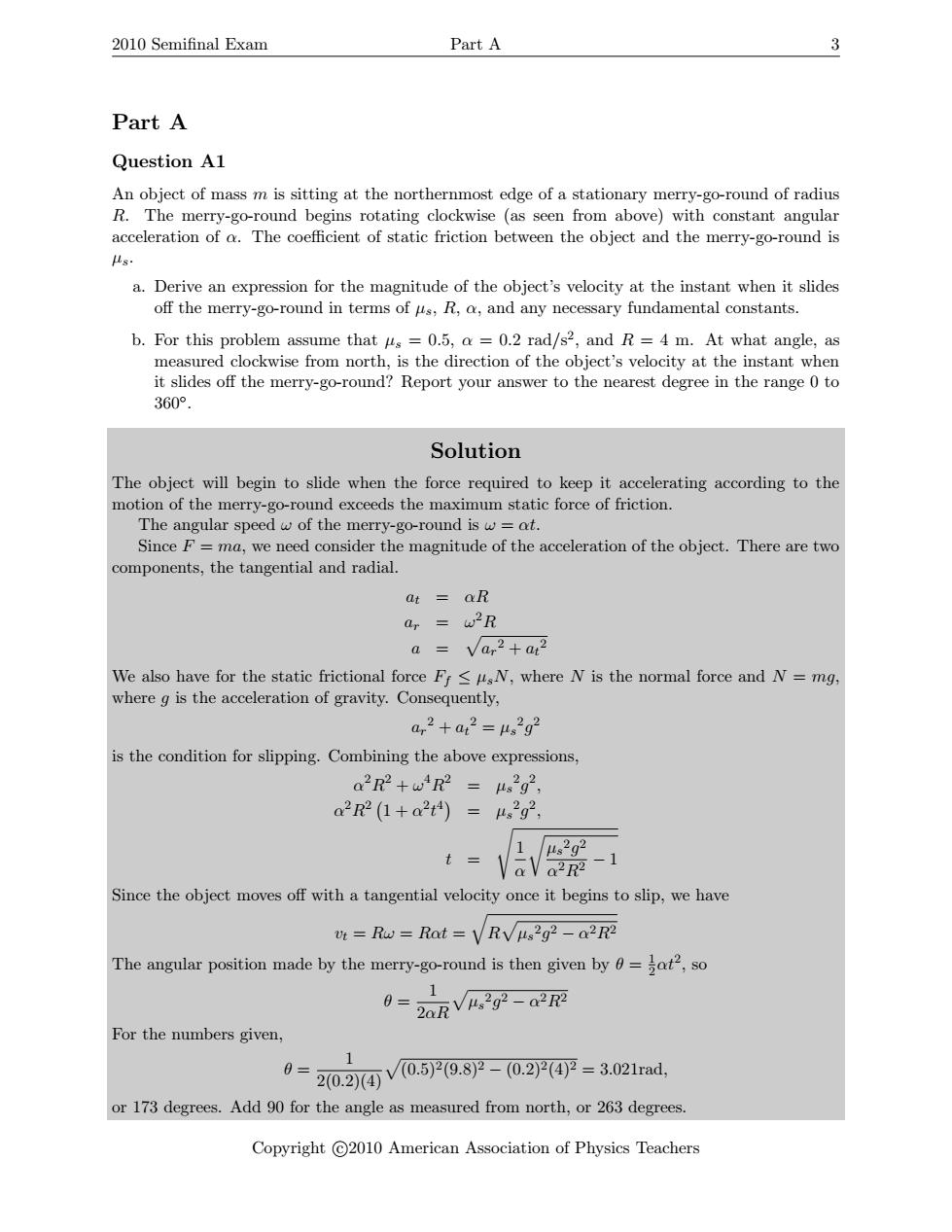正在加载图片...

2010 Semifinal Exam Part A 2 Part A Question Al An object of mass m is sitting at the northernmost edge of a stationary merry-go-round of radius R.The merry-go-round begins rotating clockwise (as seen from above)with constant angular acceleration of a.The coefficient of static friction between the object and the merry-go-round is μs a.Derive an expression for the magnitude of the object's velocity at the instant when it slides off the merry-go-round in terms of us,R,a,and any necessary fundamental constants. b.For this problem assume that us =0.5,a =0.2 rad/s2,and R=4 m.At what angle,as measured clockwise from north,is the direction of the object's velocity at the instant when it slides off the merry-go-round?Report your answer to the nearest degree in the range 0 to 360°. Solution The object will begin to slide when the force required to keep it accelerating according to the motion of the merry-go-round exceeds the maximum static force of friction. The angular speed w of the merry-go-round is w=at. Since F=ma,we need consider the magnitude of the acceleration of the object.There are two components,the tangential and radial. at aR ar =W2R a Var2+at2 We also have for the static frictional force Ff<usN,where N is the normal force and N =mg, where g is the acceleration of gravity.Consequently, a,2+at2=42g2 is the condition for slipping.Combining the above expressions, a2R2+w4R2=u2g2, a2R2(1+a2t4=u2g2, μs2g2 t aVa2R2-1 Since the object moves off with a tangential velocity once it begins to slip,we have vt Rw Rat =VRVus2g2-a2R2 The angular position made by the merry-go-round is then given by 0=at2,so 1 0= 2aRVH2g2-a2R2 For the numbers given, 0=20.2④V0.5(9.8=o.2y④=3021ad, or 173 degrees.Add 90 for the angle as measured from north,or 263 degrees. Copyright C2010 American Association of Physics Teachers2010 Semifinal Exam Part A 3 Part A Question A1 An object of mass m is sitting at the northernmost edge of a stationary merry-go-round of radius R. The merry-go-round begins rotating clockwise (as seen from above) with constant angular acceleration of α. The coefficient of static friction between the object and the merry-go-round is µs. a. Derive an expression for the magnitude of the object’s velocity at the instant when it slides off the merry-go-round in terms of µs, R, α, and any necessary fundamental constants. b. For this problem assume that µs = 0.5, α = 0.2 rad/s2 , and R = 4 m. At what angle, as measured clockwise from north, is the direction of the object’s velocity at the instant when it slides off the merry-go-round? Report your answer to the nearest degree in the range 0 to 360◦ . Solution The object will begin to slide when the force required to keep it accelerating according to the motion of the merry-go-round exceeds the maximum static force of friction. The angular speed ω of the merry-go-round is ω = αt. Since F = ma, we need consider the magnitude of the acceleration of the object. There are two components, the tangential and radial. at = αR ar = ω 2R a = p ar 2 + at 2 We also have for the static frictional force Ff ≤ µsN, where N is the normal force and N = mg, where g is the acceleration of gravity. Consequently, ar 2 + at 2 = µs 2 g 2 is the condition for slipping. Combining the above expressions, α 2R 2 + ω 4R 2 = µs 2 g 2 , α 2R 2 1 + α 2 t 4 = µs 2 g 2 , t = s 1 α r µs 2g 2 α2R2 − 1 Since the object moves off with a tangential velocity once it begins to slip, we have vt = Rω = Rαt = q R p µs 2g 2 − α2R2 The angular position made by the merry-go-round is then given by θ = 1 2 αt2 , so θ = 1 2αR p µs 2g 2 − α2R2 For the numbers given, θ = 1 2(0.2)(4) p (0.5)2(9.8)2 − (0.2)2(4)2 = 3.021rad, or 173 degrees. Add 90 for the angle as measured from north, or 263 degrees. Copyright c 2010 American Association of Physics Teachers